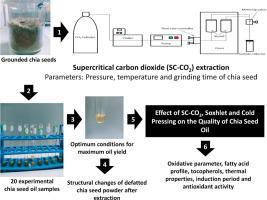Journal of CO2 Utilization ( IF 7.7 ) Pub Date : 2021-01-17 , DOI: 10.1016/j.jcou.2020.101430 Izzreen Ishak , Norhayati Hussain , Ranil Coorey , Maaruf Abd Ghani

|
Quality of chia seed (Salvia hispanica L.) oil obtained by supercritical carbon dioxide (SC−CO2) is compared with Soxhlet extraction and commercial cold-pressed oil. Response surface methodology (RSM) was conducted to determine the effect of different extraction parameters (pressure, temperature, and grinding time of chia seed) on chia seed oil yield. Linear and quadratic terms of pressure, temperature, and different particle sizes (various grinding times) significantly affected the amount of chia seed oil. The optimal extraction conditions using SC−CO2 to obtain the maximum yield of chia seed oil were as follows: chia seed particle size of 100−400 μm, 24 s of grinding time, extraction pressure of 335 bar and extraction temperature of 45 °C. However, the oil yield of chia seed extracted by SC−CO2 was lower than Soxhlet. Images captured by field emission scanning electron microscopy (FESEM) found a cracked surface in defatted chia seed powders with mostly oil released when high-pressure SC−CO2 is applied. Based on the optimized conditions, chia seed oils obtained by SC−CO2 and Soxhlet had comparable oxidation value, fatty acid composition, thermal properties, tocopherols, and antioxidant activity compared to commercial chia seed oil. However, oxidative stability test shows chia seed oil is less protected against oxidation due to the large amount of polyunsaturated fatty acids (PUFAs) more than 85 %. The present study suggests that SC−CO2 extraction is an effective method to produce chia seed oil with excellent sources of PUFAs and tocopherols.
中文翻译:

超临界二氧化碳提取正大种子(Salvia hispanica L.)油的优化和表征
将通过超临界二氧化碳(SC-CO 2)获得的奇亚籽(Salvia hispanica L.)油的质量与索氏提取法和市售冷榨油进行比较。进行了响应面方法(RSM),以确定不同的提取参数(压力,温度和奇亚籽的研磨时间)对奇亚籽油产量的影响。压力,温度和不同粒度(不同研磨时间)的线性和二次项会显着影响正大籽油的量。使用SC-CO 2的最佳提取条件要获得最大产量的正大籽油,方法如下:正大籽粒尺寸为100-400μm,研磨时间为24 s,萃取压力为335 bar,萃取温度为45°C。然而,通过SC-CO 2提取的奇亚籽的含油量低于索氏提取法。通过场发射扫描电子显微镜(FESEM)捕获的图像发现,当施加高压SC-CO 2时,脱脂的奇亚籽粉中的裂纹表面大部分释放出油。基于优化条件,通过SC-CO 2获得的正大籽油与市售的奇亚籽油相比,索氏提取物具有可比的氧化值,脂肪酸组成,热性质,生育酚和抗氧化活性。但是,氧化稳定性测试表明,由于大量的多不饱和脂肪酸(PUFA)含量超过85%,奇亚子油的氧化保护作用较差。目前的研究表明,SC-CO 2萃取是一种生产具有奇异籽油的有效方法,该籽油具有优良的PUFA和生育酚来源。



























 京公网安备 11010802027423号
京公网安备 11010802027423号